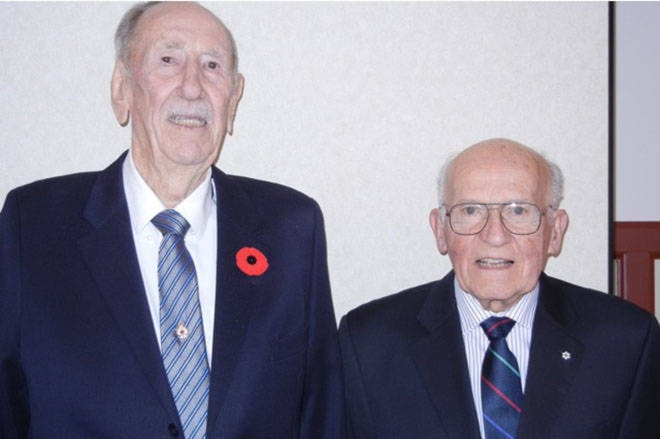The theatre room at Lakeside Manor is full to capacity and then some. There is great excitement because Bruce Aikenhead is the guest speaker. Bruce is there at the invitation of his good friend, Bill Sim.
Bruce has a binder full of information and pictures. These pages that fill his personal ‘scrapbook’ are also chronicles of Canadian history. He worked on the Avro Arrow program; after going south and working for NASA he came back to Canada and worked on the Canadarm, he helped train Canada’s original seven astronauts and eventually became director general of the Canadian Space Agency astronaut program.
“I don’t know if anyone remembers seeing a Zeppelin in the old days,” he says. “There was a great deal of excitement about this huge thing flying around the world. We made our way down to the waterfront, in Windsor, Ont. A small group of people were waiting, then low and behold it came. Some people were on board and they were looking down and waving at us and we were waving at them. And that was my first introduction to a big flying machine. That’s my start in aviation.”
By the age of 12 he was biking to the airport to study airplanes. In high school he learned the Morse Code. In 1941, Bruce was still in high school but the government offered students a graduation certificate early if their grades were good and if they planned to go into the forces, work in a factory, or learn a trade. Bruce took a radio servicing course then went off to join the air force. Because of his background they suggested he join the British Royal Air Force and he soon found himself in England. After serving time there, he and other Canadians were given another assignment.
“We asked, ‘What are we doing?’ and they said, ‘Just wait.’ We set sail but no one told us where we were going.”
The destination was India, where he was stationed for two years. After the war he took math and physics at the University of Waterloo. He married and when he graduated in 1950 he had no trouble finding a job. He was designing and manufacturing radios and TVs but he was offered a more exciting job at Canadian Aviation Electronics.
“They were building and designing a most remarkable airplane and they were looking for people…” says Bruce and his talk is interrupted by clapping. He smiles.
“It was designed to be able to fly over the North Pole and intercept the Russians. We had to be able to intercept them and shoot them down.”
Everyone in the room, of course, knows the story of the Avro Arrow, the cutting-edge of aerospace technology at the time, that was scrapped by the Diefenbaker government in 1959.
“That was the end of them,” Bruce says, “It resulted in 10,000 layoffs - such a ripple effect.”
Bruce and many others were quickly snapped up by NASA.
“I was introduced to the man who was in charge of training the pilots. The pilots had a funny name – astronauts. I was helping my new boss design the apparatus and techniques to train these pilots.”
When NASA wanted their engineers to move to Texas, Bruce and his wife decided they would rather move back to Canada. He worked on the Canadarm and eventually became the director general of the Canadian astronaut program.
When Bruce retired in 1993, he moved to B.C. where his wife, dog, and cat were waiting. He got involved in creating the Okanagan Science Centre in Vernon, which is where he met his friend, Bill.
“My first big job was to design a planetarium. We painted it to look like a starship. This is my artwork,” he says showing a picture. “We volunteered there for 10 years, right Bill?”
He mentions receiving the Order of Canada medal in 1997 and he is interrupted by clapping.
As the residents file out of the theatre one lady turns to her friend and says, “That was really interesting wasn’t it?” Her friend nods and smiles by reply.
